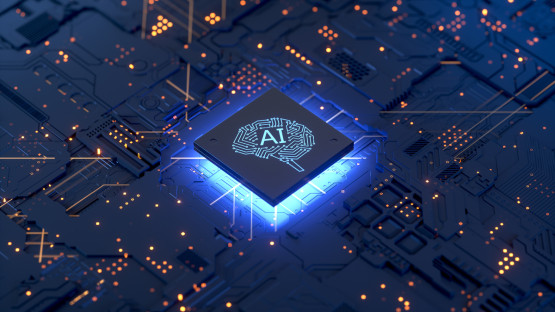
If you would like to learn more about the IAEA’s work, sign up for our weekly updates containing our most important news, multimedia and more.
Enhancing Nuclear Power Production with Artificial Intelligence
Wolfgang Picot

The IAEA is leading a coordinated research project to explore how artificial intelligence can help the deployment of small modular reactors. (Image: Adobe Stock)
Artificial intelligence (AI) holds promising potential for advancing nuclear energy production. These sophisticated computer systems mimic human logic in problem solving and decision making. With its capability to enhance efficiency, automation, safety and predictive maintenance, as well as to optimize processes, AI is already making strides in some areas of the nuclear field.
AI is an umbrella term, encompassing various technologies developed over decades. It ranges from simple computer programs, such as spam filters, to more advanced concepts like machine learning, where computers learn from past experiences through extensive training using large amounts of data. With the advent of highly potent microchips, deep learning, which involves artificial neural networks modelled after the human brain, emerged.
“ AI, together with other technologies, like digital twins, could decisively boost the efficiency of nuclear power production.
Generative AI, a subset of deep learning, has captivated the public’s attention by crafting original texts, images and videos. It is highly versatile and can be adapted to many different functions or activities. “There is legitimate excitement about what generative tools can do,” said Jeremy Renshaw, an expert on technology innovation at the Electric Power Research Institute, known as EPRI. “Existing models are very powerful, and there is currently a lot of effort to develop new and better tools.”
While generative AI can help with administrative tasks, as in other industries, its use in operating nuclear power plants (NPPs) is not yet possible due to its novelty and opaqueness; it is not yet entirely understood how artificial networks function and come to conclusions. More transparent systems called explainable generative AI hold promise for broader use in NPP operations. Developments towards such AI are underway, and Renshaw is confident that, when realized, it will allow for the use of AI in NPPs in the foreseeable future.
Machine learning applications
Machine learning has been applied in the nuclear industry for some time and has proven useful in various areas. Operators leverage machine learning algorithms for real-time monitoring and predictive maintenance. The software efficiently identifies anomalies by sifting through copious sensor data, allowing human analysts to focus on potential irregularities. “The inspector only looks at pertinent data. Instead of searching for the ‘needle in the haystack’, we remove the haystack,” Renshaw said.
This technology does not replace human analysis. However, it can deliver faster, more accurate results while relying on less, yet still indispensable, human interaction. Machine learning is already being applied to screen for cracks in metal tanks and pipes in NPPs. Enhanced precision, reduced cost and optimized human oversight from machine learning has the potential to deliver significant benefits to the nuclear power sector.
AI’s potential applications for NPPs are vast. It could, for example, bolster efficiency and ensure a steady electricity supply by adjusting power generation based on real-time data, such as consumer demand, weather and equipment performance. Automation using robotics and AI systems could handle routine tasks, focusing human intervention on high value tasks and enhancing plant efficiency. It could also optimize fuel consumption and maximize the energy output of reactors.
“AI, together with other technologies, like digital twins, could decisively boost the efficiency of nuclear power production,” said Nelly Ngoy Kubelwa, a nuclear engineer specializing in innovative technology at the IAEA. A digital twin is a digital representation of a physical object, person or process, and it can simulate real situations and their outcomes.
According to Ngoy Kubelwa, there is tremendous interest in AI solutions in the industry, but before any new technology can be used in NPPs, regulators need to know and understand it thoroughly to develop guidelines and issue licences and permits for their use.
“There is a lot of discussion around whether AI, and especially generative AI, is something so fundamentally novel that we need an entirely new approach to regulate it or whether we can adapt current standards,” Ngoy Kubelwa said. “For the deployment of this technology, we need to develop frameworks in collaboration with the regulators.”
The IAEA has supported AI’s potential application in NPPs since 2021, producing a report on AI and subsequently establishing working groups under the International Network on Innovation to Support Operating Nuclear Power Plants (ISOP) that focus on the regulatory and technical aspects of AI deployment. Forthcoming publications on AI applications for the nuclear industry and on the safety implications of AI in NPPs further underline this commitment. The IAEA is also leading a coordinated research project to explore how AI and innovative technology can help to expedite the deployment of small modular reactors, and the establishment of IAEA Collaborating Centres focused on AI is under consideration.
For Ngoy Kubelwa, the topic is not merely technical. “The use of AI and other emerging technologies will signal that the nuclear industry has the pulse for the latest development,” she said. “Proactively engaging in this sphere will play an important part in captivating the interest of the younger generation, which is vital for securing the future of nuclear energy production.”
Related stories
Related resources
- IAEA Scientific Forum 2023, 26 – 27 September 2023
- Nuclear Innovations for Net Zero, IAEA Bulletin (Vol. 64/3, September 2023)
- The Future of Atoms: Artificial Intelligence for Nuclear Applications
- AI for Atoms | International Atomic Energy Agency (IAEA) | AI FOR GOOD WEBINARS
- Department of Nuclear Energy






